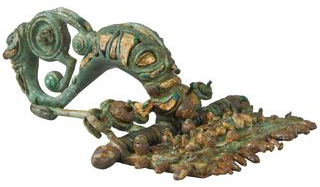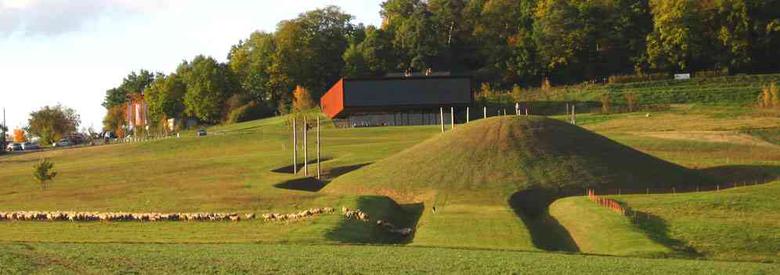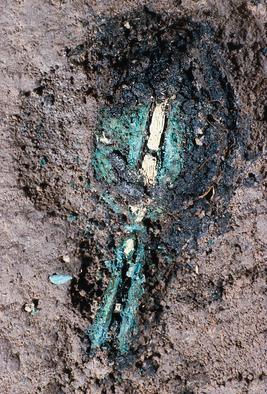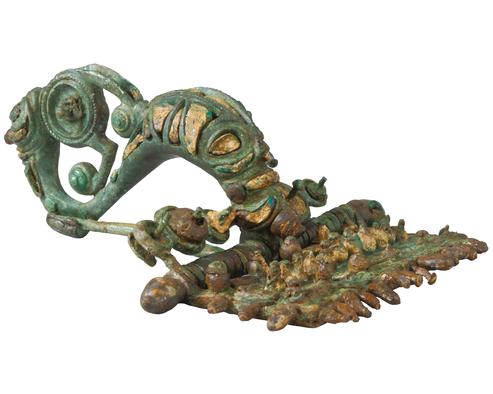|
The find of an almost life-sized sandstone statue of a Celtic "prince" in Glauberg in the German state of Hessen marked the beginning of an exciting journey to the early Celtic past of the 5th century BC, an age rich in myths and mystery due to the absence of written records. With their meticulous restoration of the valuable finds under the stereo microscope, restorers are helping to piece together the puzzle of our Celtic ancestors. |
 |
|
"The Glauberg is still a very special place, just as it was 2,500 years ago," finds Dr. Ines Balzer, Head of the "Keltenwelt am Glauberg" research center. Here, roughly 30 kilometers north east of Frankfurt am Main, an almost life-sized Celtic sandstone statue was found in 1996 – a sensational discovery that is the only one of its kind in Europe so far and one that has radically changed our understanding of early Celtic culture. |
 |
Who were the Celts? Evidence of a common culture stems from the 8th century BC. The first recorded use of the word Celts was by the Greek geographer Hecataeus of Miletus around 500 BC and then by Herodotus around 450 BC. The Celts probably did not see themselves as a coherent ethnic group, and had no common language. Their settlement area spread from the mouth of the Danube to Marseille, and to the river Main in the north. The Glauberg is therefore situated in the outermost region of the settlement area. As they had no written language, all we know about them comes from the pen of their enemies or has survived in the form of archaeological remains. We know that the Celts lived in an agricultural society and adopted many technical skills of the Mediterranean, such as iron-working in the 8th century BC, wheel-made pottery at the end of the 6th century BC or the minting of coins at the beginning of the 3rd century BC. After Caesar’s conquest of Gaul in the first century BC, Celtic culture was gradually assimilated into that of their Roman conquerors and the Celts disappeared from the historical stage.

Fig. 1: At the center of the circular ditch, there is now a reconstructed six-meter high burial mound. From the museum behind, the visitor’s eye is guided out of the museum over the excavation site like looking through a telescope. (Photo: I. Balzer)
Archaeologists already investigated the Glauberg area in the 1930s, concentrating on the settlement on the hilltop plateau. In the 1990s, aerial photos taken during an exploratory flight over the hillside revealed a burial mound which led to more specific digging. The following years brought not only the famous statue to light but also three graves in two burial mounds with valuable burial objects and an extensive wall and ditch system of unique dimensions but of as yet unknown significance. "We think that the site is an important Celtic religious center dating from the 5th century BC," says Ines Balzer. A large circular ditch with an outer diameter of 68 m, a width of up to 14 m and depth of four meters opens in the south east into two parallel straight ditches, the so-called processional way. "This 350 meter long way does not follow any topological feature – on the contrary, it crosses a slightly elevated ridge," says Balzer. "Knowledge of astrophysics suggests that this way pointed toward the major lunar standstill in the south, which only takes place every 18.6 years." The presence of many remains of posts on the site gave rise to the theory of a Celtic "astronomical calendar". However, it is now known that the posts never stood there at the same time. Their real function is still a mystery today.
 |
 |
|
| Fig. 2a: A part of a fibula during excavation in the field … (Photo: A. Ulbrich) | Fig. 2b: … and the richly decorated mask fibula after restoration. (Photo: W. Fuhrmannek) |
At the center of the circular ditch, there is now a reconstructed six-meter high burial mound which housed two warriors’ graves with numerous burial objects. While recovering the finds, the excavation team made an important decision, setting a new precedent for future restoration projects. Frank Bodis, head of the hessenArchäologie restoration workshop in Wiesbaden, recalls: "To avoid destroying the smallest detail, we decided to do a block excavation. This involved sawing the entire grave out of the earth en bloc and transporting it to the restoration workshop. This expensive and time-consuming method has the invaluable advantage that the finds remain in their original context and can be treated under laboratory conditions. First we x-rayed the block, which had to be kept damp and at a carefully controlled temperature. Then we removed the finds layer by layer, documenting the position and context of each item.
The objects that landed on the desks and under the microscopes of the restorers presented genuine challenges. "We’d been able to detect a richly decorated mask fibula in the x-ray. But as this piece of jewelry was in an extremely poor state and badly corroded, I had to turn the fibula block over first and uncover the underneath so as not to risk damaging the fragile fibula when I removed it," explains restorer Angelika Ulbrich. "Using extremely fine tools, I was able to remove the earth and the corrosion products of the fibula millimeter by millimeter under the microscope. It was sumptuously decorated with 109 corals and adorned with two mask-like figures, whose significance we are not able to interpret today."
|
Fatigue-free work at the microscope
The microscope is one of the restorers’ main tools. "90 per cent of the time we work with the Leica MZ6 microscope to detect the finest structures without destroying the surface," says Ulbrich. The Leica stereo microscopes of the M series have two parallel beam paths and a common main objective, and are parfocally matched. This intricate optical system guarantees fatigue-free viewing and constant focus when changing magnification, and allows extremely easy adaption of all kinds of accessories. With the wide range of ergonomic accessories, restorers can work in comfort at the microscope for many hours at a time.
Months of patience and professional skill for jug restoration
Restorer Monica Bosinski also remembers a particularly challenging object: "The restoration of the beaked jug from the first grave took over a year." The beaked jug of Glauberg is one of only six known Celtic jugs of this type that has been modeled on Etruscan prototypes. |
Fig. 3: The microscope is one of the restorers’ main tools. Restorer Angelika Ulbrich works with a Leica MZ6 stereomicroscope. (Photo: K. Pingel) |
Thanks to the block excavation it was possible to rescue many organic materials that would have been destroyed had they been exposed to light and oxygen at the site. "It is well known that organic materials such as wood, textiles or leather are preserved in combination with metal oxides. The wood on the hilt of the sword, leather residue in the belt hook or material on the fibula – these organic finds offer scientists a wealth of information."
|
Fig. 4a: The beaked jug from the first grave was in a very fragile condition. (Photo: W. Hartmann) |
Fig. 4b) Its restoration took over a year. (Photo: U. Seitz-Gray) |
Restoration work was finished in 2009 after around 14 years. 175 separate items found at three sites have been treated and are awaiting further scientific evaluation. In future, special examinations may provide answers to questions that are still unresolved, such as: Which quarry was the sandstone for the Celtic prince taken from? Where did the Celts get the gold and coral for the burial objects? Where did the iron smelting processes take place? What was the source of the economic wealth? DNA analysis of the bone remains could reveal how the buried warriors were related to each other. The Glauberg is still veiled in many mysteries and unanswered questions – but this surely adds to the unbroken spell it still casts today. The museum has just welcomed its 190,000th visitor since it opened in May 2011, in May 2013 the groundbreaking ceremony for the new museum garden was held. With a bold new museum building directly at the site where the finds were made, the 37-hectare archaeological park and the research center, the "Keltenwelt am Glauberg" follows its motto "Creating a historical experience". While the visitor’s eye is guided out of the museum over the excavation site like looking through a telescope, a walk through the ditches and over the burial mounds gives a true feel for the dimension of the settlement. The research center under the management of Ines Balzer still has plenty of space for investigating new questions with modern methods to find out the secrets of this special place called the Glauberg.